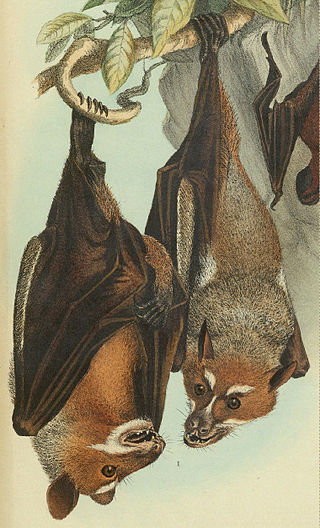
The Dasyuridae are a family of marsupials native to Australia and New Guinea, including 71 extant species divided into 17 genera. Many are small and mouse-like or shrew-like, giving some of them the name marsupial mice or marsupial shrews, but the group also includes the cat-sized quolls, as well as the Tasmanian devil and the extinct thylacine. They are found in a wide range of habitats, including grassland, underground, forests, and mountains, and some species are arboreal or semiaquatic. The Dasyuridae are often called the 'marsupial carnivores', as most members of the family are insectivores.

The spangled kookaburra also called Aru giant kingfisher, is a little-known species of kookaburra found in the Aru Islands, Trans-Fly savanna and grasslands of southern New Guinea. Practically nothing is known of its family life or breeding biology.

The short-furred dasyure, also known as the short-haired marsupial mouse, is a member of the order Dasyuromorphia. It was once recognised as the only species in the genus Murexia, but now five species are recognised. It lives in Papua, Indonesia and Papua New Guinea.

The three-striped dasyure is a member of the order Dasyuromorphia. This marsupial carnivore lives in West Papua and Papua New Guinea.

Murexia is a genus of mouse-sized dasyure, in the marsupial order Dasyuromorphia. They are found in Papua, Indonesia and Papua New Guinea.

The Phascogalini are a tribe in the family Dasyuridae, comprising seven genera of small marsupials native to Australia and New Guinea.

The striped possum or common striped possum is a member of the marsupial family Petauridae. It is found mainly in New Guinea. The species is black with three white stripes running head to tail, and its head has white stripes that form a 'Y' shape. It is closely related to the sugar glider, and is similar in appearance.

Wallace's fruit dove is a species of a bird in the pigeon family Columbidae. The name commemorates the British naturalist Alfred Russel Wallace. It is a rather large, long-tailed fruit dove with a length of 24–28 cm (9.4–11.0 in) and has been described as "one of the most beautiful" fruit doves. The forehead and crown are dull crimson, the lower face and throat are white, and the rest of the head, breast, neck, and upper back are pale bluish-grey. The wings and lower back are green and the belly is orange, separated from the chest by a white band. Both sexes look similar, but females have less extensive red on the head and a greenish tinge to their grey parts.

The Moluccan megapode, also known as Wallace's scrubfowl, Moluccan scrubfowl or painted megapode, is a small, approximately 31 cm long, olive-brown megapode. The genus Eulipoa is monotypic, but the Moluccan megapode is sometimes placed in Megapodius instead. Both sexes are similar with an olive-brown plumage, bluish-grey below, white undertail coverts, brown iris, bare pink facial skin, bluish-yellow bill and dark olive legs. There are light grey stripes on reddish-maroon feathers on its back. The young has brownish plumage, a black bill, legs and hazel iris.

The Habbema dasyure is a species of marsupial in the family Dasyuridae found in West Papua, Indonesia, and Papua New Guinea. Its natural habitat is rocky areas.

The black-tailed dasyure is a species of marsupial in the family Dasyuridae.

The long-nosed dasyure is a species of marsupial in the family Dasyuridae. It is found in Indonesia and Papua New Guinea. Its natural habitat is subtropical or tropical dry forests.

The dusky pademelon or dusky wallaby is a species of marsupial in the family Macropodidae. It is found in the Aru and Kai islands and the Trans-Fly savanna and grasslands ecoregion of New Guinea. Its natural habitats are subtropical or tropical dry forests, dry savanna, subtropical or tropical dry shrubland, and subtropical or tropical dry lowland grassland. It is threatened by habitat loss.

The Wallace's or Sulawesi stripe-faced fruit bat is a species of megabat in the family Pteropodidae. It is endemic to Sulawesi and the nearby Togian Islands of Indonesia. Cave paintings resembling these bats have been found in Australia, where bats of this kind are not otherwise known.

Myoictis or striped dasyure is a genus of marsupials in the order Dasyuromorphia. It is found in New Guinea.
The Tate's three-striped dasyure is a member of the order Dasyuromorphia. This marsupial carnivore lives in New Guinea. It inhabits primary montane forest. Like its congeners, it is thought to be diurnal and largely terrestrial.
Woolley's three-striped dasyure is a member of the order Dasyuromorphia. This marsupial carnivore lives in Papua New Guinea.

Batocera wallacei, common name Wallace's long-horn beetle, is a species of flat-faced longhorn beetle in the subfamily Lamiinae of the family Cerambycidae. The species name honors Alfred Russel Wallace, who discovered this longhorn beetle on the Aru Islands in Indonesia. It was named after him by James Thomson in 1858.
Wallace's tarsier, Tarsius wallacei, is a species of Sulawesi tarsier. It is found in the forests of what is referred to geologically as the neck of Sulawesi where there are two separate populations. It is a small brown arboreal primate of the infraorder Tarsiiformes less than 15 cm (6 in) long.

















